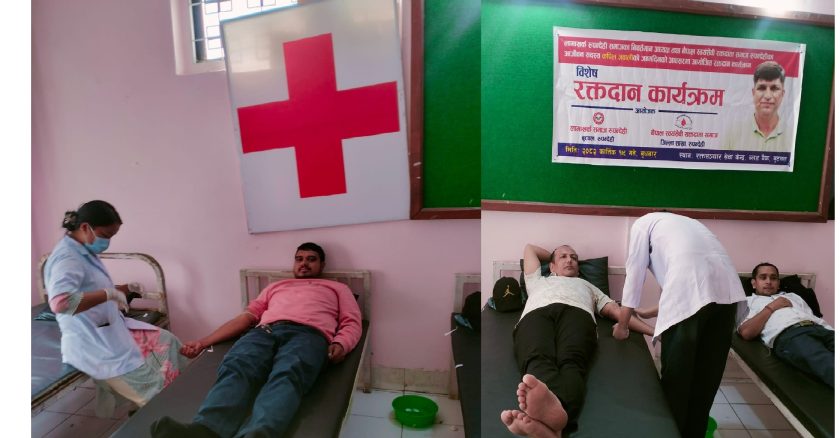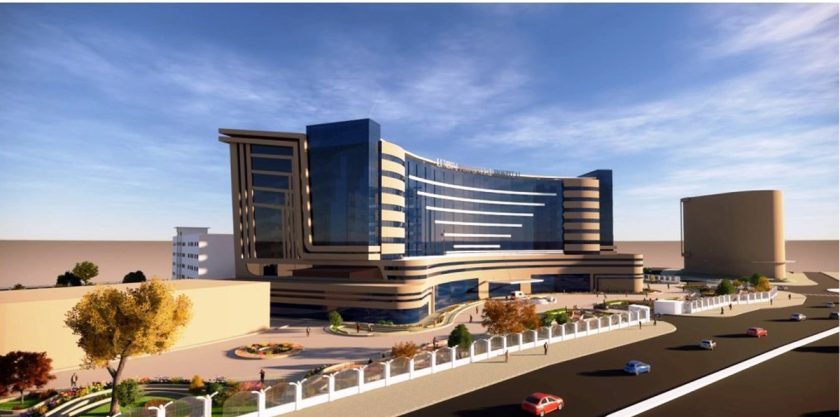Healthnews/In a groundbreaking medical feat, Dr. Hariom Keshari, a Senior Consultant General Practitioner and Public Health Expert (MDGP, MPH) from Nepal, has set a new world record for the Fastest Baby Delivery During a Caesarean Section Surgery, officially recognized by the International Book of Records (IBR) & Elite World Record independently.
Dr. Keshari successfully delivered a baby within just 43 seconds from the initial skin incision — surpassing the previous global record of 1 minute and 5 seconds. The procedure was performed under emergency conditions at Dodhara Chandani Hospital in Sudurpaschim Province, showcasing not only remarkable surgical precision and speed but also a profound commitment to maternal and neonatal care in resource-limited settings.
“This achievement is not just a personal milestone, but a tribute to every healthcare professional working under challenging conditions to save lives,” said Dr. Keshari.
Key Highlights:
Record Title: Fastest Baby Delivery During a Caesarean Section Surgery
Time: 43 seconds from skin incision to delivery
Date: 13 May 2025
Location: Dodhara Chandani Hospital, Kanchanpur, Nepal
Verified by: International Book of Records (IBR) & Elite World Record (EWR) independently.
Under processing: At major global platforms & journals including Guinness World Record.
The IBR & EWR has officially confirmed the record after reviewing video evidence, documentation, and witness testimony.
Background of case-
A 25-year-old pregnant woman, at 40 weeks and 6 days gestation, presented to the emergency obstetrics unit with oligohydramnios (ultrasound confirmed reduced amniotic fluid index (AFI = 5), severe pregnancy-induced hypertension, and a 9-year inter pregnancy gap with history of one previous safe vaginal delivery and one first-trimester spontaneous abortion underwent induction of labor with mutual patient decision to try first for normal delivery under close & regular fetal heart monitoring which after 3 hours revealed acute persistent fetal distress necessitating an immediate decision for Caesarean delivery.
She was counseled, consented, and rapidly prepared for emergency/ crash CS of First Category due to life threatening condition to save the lives of baby & mother & to prevent hypoxic injury in baby like Hypoxemic Injury Encephalopathy, reduce the chance of NICU admission & prevent morbidity especially in peripheral setup with limited resources with fetal distress to baby delivery time being 15 minutes.
Outcome of case-
The baby was delivered with immediate active cry & Apgar score of 8/10 & 9/10 at 1 & 5 minutes, less bleeding, less operative time & less need of anesthesia/ analgesics, less maternal discomfort, quick post-operative recovery & baby actively breast feeding with no neonatal & maternal complications with great success.
Had the case been not done in time & baby taken out in time, the results would have been grave which proved in one of the recent other case of 15th July where in the process of induction baby suffered persistent tachycardia (Fetal distress) & was counseled for immediate emergency caesarian section surgery at 2 am in night but patient party didn’t believed the team & denied due to lack of NICU facility & taken to some hospital with still birth & Post Partum Hemorrhage with mortality & morbidity which is just an example stating immediate extraction of baby in time could prevent neonatal & maternal mortality & morbidity.
Evidences supporting fast delivery of baby linked with better neonatal & maternal outcomes
1)Decision-to-delivery interval and neonatal outcomes: A systematic review and meta-analysis
Journal: American Journal of Obstetrics and Gynecology (AJOG)
Key Findings: Shorter skin-to-delivery times significantly reduce hypoxic injury risk in fetal distress.
2)Impact of incision-to-delivery time on neonatal outcome in emergency cesarean section for fetal distress
Journal: Journal of Obstetrics and Gynaecology Research
Key Findings: Incision-to-delivery time <2 minutes linked to improved Apgar scores and reduced NICU admission.
3) Emergency caesarean section and decision-to-delivery interval: A review of literature
Journal: European Journal of Obstetrics & Gynecology
Key Findings: Emphasizes urgent baby extraction in reducing asphyxia and improving neonatal outcomes.
4) Evaluating the decision-to-delivery interval and its effects on neonatal outcomes in a resource-limited setting
Journal: International Journal of Gynecology and Obstetrics (FIGO)
Key Findings: Shorter incision-to-delivery times improve survival rates even in peripheral hospitals.
5) Reducing perinatal mortality in emergency cesarean section: Role of prompt surgical extraction
Journal: PLOS ONE
Key Findings: Extraction within 60–90 seconds lowers brain injury risks in Category I emergencies.
6) Safe motherhood and perinatal outcomes: Significance of rapid delivery in emergencies
Journal: Bulletin of the WHO
Key Findings: Highlights positive maternal and neonatal outcomes due to rapid response in LMICs.
7) Does time matter? The effect of rapid delivery during fetal distress
Journal: BJOG: An International Journal of Obstetrics and Gynaecology
Key Findings: Shorter delivery time (2 mins) improves intact survival rates in Category 1 C-sections.
Background of Hospital where record attempt was done-
Its Dodhara Chandani Municipality 15 beded hospital with limited resources & in periphery, in Kanchanpur, Sudhurpaschim Province, Nepal which was a Primary Health Care center (PHC) upgraded to primary hospital with the support of Nick Simon Institute (NSI), an INGO providing team of medical personnel headed by MDGP, General Practitioners as clinical coordinator. Patients were compeled to go to nearby private hospitals in Kathima in Utarrakand India and Mahendranagar & Dhangadi in Sudhurpaschim, Nepal risking the lives of mothers & babies on the way with financial & mental burden, mortality & morbidity when full 24 hours CEONC service was not started or 2 years back.
About Dr. Hariom Keshari:
Dr. Keshari from Kalaiya-04, Bara, Madhesh Province, Nepal has over 15 years of experience in comprehensive & emergency obstetric and neonatal care, serving mostly in rural and underserved regions of Nepal like in Accham District Hospital, Mangalsen, Khotang District Hospital, Diktel and others. His tireless work under the support of the Government Hospitals, Nick Simons Institute and various organization has impacted thousands of lives and inspired a new generation of medical professionals.
He has completed his MBBS from Manipal College of Medical sciences, MCOMS, Pokhara under Ministry of Education scholarship scheme under Kathmandu University, MD in General Practice & Emergency Medicine from NAMS, National Academy of Medical sciences, Bir Hospital, Kathmandu under scholarship, Fellowship in Cardiac Critical Care & Echocardiography (FICCC, FIECHO) from TSS, New-Delhi and Masters in Public Health (MPH) from Tribhuwan University.
He has established 24 hours CEONC service at Accham District Hospital, Mangalsen under his leadership with teamwork, courage, determination & coordination 15 years back, now called Accham Provincial Hospital under federalism in Nepal just being a medical officer in his first posting only after 10 weeks of training in Kathmandu at Maternity & Womens Hospital, Thapathali of 10 weeks duration of Advanced Skilled Birth Attendant as 1st batch with only three medical officers from periphery.
Besides, he has provided family planning services including Minilap, No-scalpel Vasectomy at peripheral camps in remote areas & at hospitals, helped & performed normal & complicated deliveries, Post-abortion care & safe abortion services mentoring, teaching and training health personnel & nursing team.
He has dealt with thousands of medical, gynecological, dermatological, basic psychiatric, orthopedics, critical, Emergency trauma, poisoning or other cases & surgical cases from minor incision & drainage to intermediate like hydrocele, hernia, piles, phimosis, tendons repair to major including Emergency Appendectomy, Emergency Laparotomy for duodenal perforation and Emergency laparotomy for ruptured ectopic pregnancy.
In peripheral government hospitals where pediatricians are not available and referrals are either cost-prohibitive or geographically challenging, he has stepped in to manage neonates with a range of critical conditions. This includes early-onset neonatal sepsis, pneumonia, and mild to moderate birth asphyxia, hypothermia, and hypoxemia requiring up to CPAP but not ventilator support.
In the absence of dedicated anesthetists in CEONC settings, he has regularly guided, taught, and supported anesthesia assistants in delivering spinal, IV, local, and regional anesthesia techniques. In emergencies where no anesthesia personnel were present, he has personally administered spinal anesthesia & blocks and coordinated with available medical staff for intraoperative monitoring, enabling critical surgeries to continue without delay.
Using Ultrasound for Better Rural Diagnostics, in his years of rural service, he has consistently used bedside/ routine ultrasound to improve early detection and referral of obstetric, gynecological, and abdominal-pelvic complications. This has greatly improved diagnostic accuracy, reduced unnecessary delays, and supported decision-making in environments without formal radiology services.
At the heart of His work lies a deep commitment to public health equity — the belief that no woman or child should die due to preventable causes, no matter how remote or under-resourced their community may be.
Strategy to overcome against recent trend/ challenge/ issue of Nepal Consumer’s Court unbalanced/ illogical Compensation act without established health insurance for compensations for doctors in background of record attempt.
Dr. Keshari & team uses the balanced fast mode of baby extraction only in Category 1st / Crash Emergency Caesarian section surgery indications as fetal distress & others to save lives of newborns & mothers minimizing decision (ideally acute fetal distress) to delivery interval to 15 minutes to less than 30 minutes as per standard protocol with complete ethical guidelines & full alertness and explaining all possible adverse outcomes possible with informed consent & most importantly after baby extraction he & his team uses normal safe mode to minimize any operative maternal complication.
Moreover, he uses scientific evidence based blunt dissection technique (Misgav Ladach) with less tissue trauma, less injury, less bleeding, less anesthetic need, less operative time & ultimate better operative & postoperative recovery & outcomes. In all other case of caesarian sections, he & his team uses normal balanced mode taking time to minimize any possible complications without any rush for better outcomes.
Team of record attempt
Team was led by Dr. Hariom Keshari , the chief surgeon & assistants Dr, Aditya Verma (medical officer), Durga Patali (Scrub Nurse), Kamala Mahata (Baby receiver Nurse), Shankar Kunwar (Anesthesia Assistant), overall supervision & help by Acting Medical Superintendent Dr. Jeevan Kiran Snehi & Arjun Labad, Garima Joshi & Dipika Joshi (Both 3rd year Health Assistant students in OGT for observing & learning by chance Mobile video shooter), Post operative care by (Laxmi Bhatt Joshi (Nursing incharge), Swostika Sunar, Anu Timalsina) and helping office assistant Indira Devi & (recording reporting) Uddhav Luhar and others.
Source of inspiration for the record attempt
Dr. Ashima Taneja, Professor & Head, Department of Obstetrics and Gynaecology, Dayanand Medical College & Hospital, Ludhiana, who had achieved a remarkable world record for the “Fastest to Deliver Baby During a Caesarean Section Surgery” in 65 seconds breaking the earlier documented record of 2 minutes. This achievement has been recognized by the International Book of Records on Nov 21, 2024.
Special thanks to Dr. Shirley Heywood 15 years back initially from INF, Surkhet for mentoring & teaching him at Accham District Hospital, Mangalsen about evidence based Joel-Cohen approach for faster baby extraction in emergency Category 1st caesarian sections which he has been practicing from last 15 years in such cases.
Self-realization of the fact the as a routine in recent years in Category 1 / crash Emergency Caesarian setion surgery he delivered baby completely from skin incision in less than 1 to 2 minutes after practice & experience of decade in the field with successful maternal & neonatal outcomes.
Fate of record attempt
This record breaking achievement highlights the exceptional teamwork, precision, and coordination of Dr. Keshari and his team, showcasing their ability to respond swiftly when every second counts.
This achievement reflects global standards of excellence in surgical care and brings well-deserved international recognition to Nepal’s healthcare frontliners.
Overall Conclusion
With effective teamwork, dedication and coordination even with limited resources in peripheral setup world-class achievements of any kind is possible.






प्रतिकया दिनुहोस्